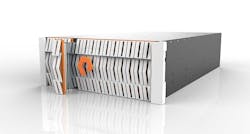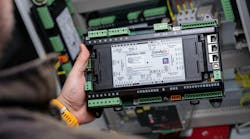We’re not deploying data centers the way we used to. There are important new options to consider in infrastructure design, and an important one is all-flash storage.
Research from IDC predicts that service providers will continue to break new ground in search of both performance gains and cost reductions as they expand their cloud implementations. Remember, as data center utilization increases, so do requirements for power and cooling. And that’s where data center leaders are getting creative.
What if your design engineers came to you and said, “Boss, with new design and density considerations, we can actually remove 20 racks of disk, along with ALL of the associated floor space, power, and cooling. We can replace all of it with a single 4U flash-enabled architecture.” Would you listen? I’m sure you would. Your mileage may vary, but these type of examples exist.
Saving Cooling, Power, and Space, all in a Flash
Traditional data center design used to revolve around the monolithic deployment of resource silos. Although this worked for a while, new design specifications must be taken into consideration when working with emerging digital strategies. All-flash solutions are enterprise-ready and must be considered in-line with disk-based solutions when renovating, updating, or designing a new data center.
It’s important to understand the market. The stability and reliability around all-flash arrays has made them a popular item to replace legacy spinning disk solutions. The recent IDC Worldwide Enterprise Storage Market Tracker indicates that total capacity shipments were up 16.5% year over year to 65.3 exabytes during the Q2 2017.
“The enterprise storage market finished the second quarter of 2017 on a positive note, posting modest year-over-year growth and the first overall growth in several quarters,” said Liz Conner, research manager, Storage Systems at IDC. “Traditional storage vendors continue to expand their product portfolios to take advantage of the market swing towards All Flash and converged/hyperconverged systems. Meanwhile, hyperscalers saw new storage initiatives and event-driven storage requirements lead to strong growth in this segment during the second quarter.”
As IDC points out, the total all-flash market generated over $1.4 billion in revenue during the quarter, up 37.6% year over year. The Hybrid Flash Array (HFA) segment of the market continues to be a significant part of the overall market with $2.1 billion in revenue and 19.6% of the total market share.
How this Impacts the Economics of Your Data Center.
I’m going to reference a specific vendor here, Pure Storage. But keep in mind that almost any leading all-flash array offers the capability to reduce space and save on power and cooling. The biggest differences will be in feature sets, design, and integration.
In a recent report from Forrester (commissioned by Pure), analysts examined the economic impact of removing legacy spinning disk and replacing them with all-flash solutions. Interviewed customers reported significant power and cooling savings when they replaced legacy disk storage with all-flash technologies. For the various organizations, power and cooling savings totaled $74,231 over three years and assume a cost per kWh (kilowatt hour) for power of $0.14 and a cost per kWh for cooling of $0.10. Remember, these savings can be even greater if you’re operating multiple distributed data centers with several racks of spinning disk.
This is a serious consideration given the fact that power costs actually continue to rise in many areas. Gartner estimates that ongoing power costs are increasing at least 10 percent per year due to cost per kWh increases and underlying demand, especially for high-density servers. Power routinely represents approximately 10 percent of data center operating expenditure, and is likely to be about 15% of data center opex within five years.
“In most cases, improving IT equipment power usage can result in the greatest overall improvement in power usage efficiency,” said Henrique Cecci, research director at Gartner.
Many data center markets offer lower power and energy costs. Even with a lower power price, you can still save on space, power usage, and on actual gear required to cool your data center.
With this in mind, let’s look at some key considerations when leveraging all-flash technologies as part of your data center design strategy:
All-flash are purpose-built arrays that enable a reduction in data center power and cooling.
Remember, this not only reduces power and cooling overhead, but in some cases it can reduce or eliminate the need to build new data centers in the first place. It can also help organizations with bigger data requirements to decide whether to rent or own their data center space. This reduction in real estate burden can help with infrastructure design and architecture.
With all-flash technologies, you’re creating greater levels of density. Plus, new data management techniques mean that you’ll require fewer drives to get the job done. With SSD and all-flash arrays, you create more IOPS, with faster read/write capabilities. This means that you can deploy virtualization environments, applications, and even things like VDI with significantly fewer disks.
The big benefits here are less latency, improved performance, no moving parts, and a lot of speed. This also means you can take on new initiatives around consolidation, big data, and even creating a more robust cloud platform.
It’s common to see the reduction of 6-10 racks into 3-7U.
With solutions like those from Pure, you can now effectively house 1PB of data in 3U. Similarly, 20U can house 8PB of effective storage. As I mentioned earlier, this is quite different from the way we used to deploy spinning disk into our data centers. You’re not only reducing the amount of space due to the density and efficiency of an all-flash array, you’re also adding capabilities. For example, to match the performance requirements of a robust VDI ecosystem, we’d need to throw a lot of disk to match the IOPS needs. Too often, storage acted as the bottleneck to better user experience. Now, this can be accomplished with high-density all-flash systems, requiring fewer drives to get the job done.
All-flash systems allow you to leverage better technologies while actually utilizing less space. With that said, it’s important to note that although you require fewer all-flash drives to achieve greater amounts of IOPS and performance, other big savings come from new solutions around deduplication and compression. Oftentimes, this is offered as a part of the all-flash solution; and sometimes this is an overhead cost.
You create a more resilient ecosystem.
With the ability to provide totally non-disruptive upgrades, those customers whose revenues, development, and operations rely on 24/7 access aren’t impacted during upgrades, maintenance, or other unplanned disruptive events. Newer all-flash solutions can offer six to seven “nines” of uptime (meaning 99.9999 percent uptime or better). This equates to mere seconds of downtime a year, if any.
The other big factor is your ability to recover both your data center and specific files very quickly. Due to the design, all-flash will allow you to by up and running faster than other solutions. This means bringing up VMs, applications, and even remote sites more quickly.
You enable more capabilities for converged infrastructure (CI).
Let me give you a specific example: FlashStack. This is a converged infrastructure solution coupling Cisco UCS/Nexus architecture with Pure Storage. Recently, a customer with some serious space constraints because of their spinning disk architecture looked at this solution for a redesign. This next part is crazy: They went from 40 racks of equipment, more than 4 rows in their data center, down to 2 racks of FlashStack. When you look at overall data center cost, this is a huge cost reduction across all areas of power, cooling, and space utilization.
The cool part here is that you’re leveraging blades which are intelligently designed to work within a validated design with the underlying storage controller. You can integrate the management ecosystem to ensure resources and infrastructure are all efficiently managed.
Are You Ready for All-Flash?
A big challenge for all-flash arrays has been resiliency, redundancy, and uptime. Just a few years ago, as all-flash was catching on, we were still testing out these systems to ensure they were resilient and could perform.
Today, this is much different. I still face some hesitation around all-flash solutions, especially when the conversation turns to replacing primary storage with an all-flash array. A lot of these concerns can be addressed with the development of newer and better all-flash arrays. There are several enterprise solutions from HPE (Nimble), Pure Storage, EMC, NetApp, Tintri, and others that are solid, enterprise-ready architectures.
My best recommendation would be try these systems out. Place one in parallel to your primary systems and understand where there are benefits around your specific use-case. This way, you can test our your own applications and workloads prior to deploying it in production.
Final Thoughts
I’ve been working on several data center projects where the introduction of all-flash systems fundamentally changed the economics of the business and the data center customer. Each time, we saw massive savings around cost, time to deploy, utilization, and infrastructure design. We consistently saw end-user performance improve. This went across the board, based on what resided on the all-flash array. This means VMs, databases, virtual applications, and even VDI performed better.
Here’s the other big takeaway: When combined with converged infrastructure, all-flash solutions also enabled our customers to take on emerging digital projects. In fact, machine learning data analytics, AI platforms, and big data initiatives all perform better on all-flash solutions. And, it’ll take up way less space.
As you read all of this, take a minute to think about your own data center. Are there legacy components? Just because they’re “working,” are they bringing you any value? Are you fighting a challenge of an ever-expanding data center?
I’ve seen many projects where the key driver is to create a better economic model for the data center. A major driver for these projects are the emerging capabilities around all-flash and converged infrastructure. Remember, each use case is unique, and every organization will have different types of requirements. However, in any data center project looking to expand data and compute capabilities, all-flash solutions must be a consideration.
About the Author



